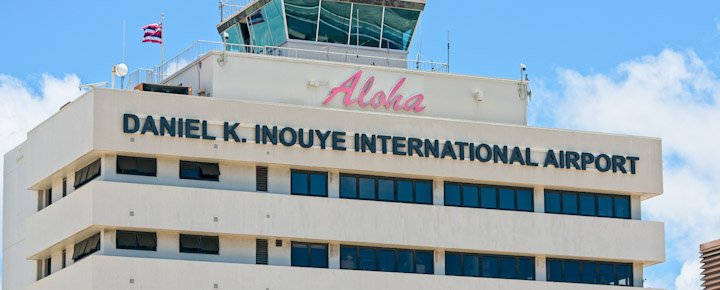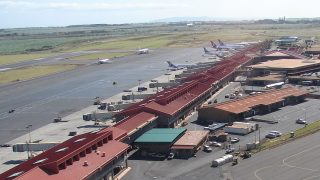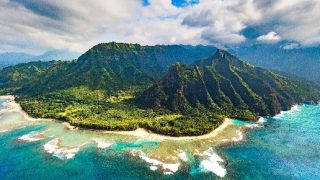Kauai’s Lihue Airport (LIH) has needed to adapt to federal airport requirements that have existed for 15 years! It is the only airport in the United States that hasn’t yet complied with these FAA rules. That work was finally approved last year, and while it was to get underway in 2023, it looks like it may instead start later this month. This work, however, is not the prior airport master plan, which was rejected (details below).
Shifting the LIH runway away from the ocean.
The runway will be shifted by just under 1,000 feet to increase the safety buffer surrounding it for any landing problems that might occur. New LED lighting will also be installed, among other FAA-approved changes.
At present, the runway is less than 300 feet from the Pacific Ocean, and it is to shift west or inland. Due to the complexities associated with its land constraints, the airport has been exempted from FAA mandates for a decade while it performed the work, including environmental assessments, needed to actually commence.
Expect first nightly closures starting July 29.
The Hawaii Department of Transportation (HDOT) announced these imminent construction activities, now scheduled to begin on Runway 3-21 at Lihue Airport (LIH) starting July 29, 2024. The next phase will include nightly closures of that runway from 11 p.m. to 8 a.m. to install a temporary jet blast deflector, allowing daytime flight operations to continue. This is part of the larger Relocate Runway 3-21 Project, aimed at increasing the Runway Safety Area, extending Taxiway A, and installing new LED lights and signage.
The project needed to comply with Federal Aviation Administration safety requirements and is scheduled for completion by January 2026. As the overall process proceeds, passengers should continue to check with airlines for specific flight information. We will have further updates as more details are revealed.
Will this impact evening Kauai flights?
The last flights to and from Kauai are typically scheduled during the 10:00 pm hour. Thus, during normal operations, this next progression should not impact flights that are operating as scheduled.
The next phase of work will occur from July 29 until August 2, when Runway 3-21 is planned to be closed nightly from 11 p.m. to 8 a.m. to install a temporary jet blast deflector. Alternate runway 17-35 will remain in service during the overnight work. The airport are planned to operate normally outside of the scheduled night-work hours. This work was previously planned to start on July 15.
Why does the work need to start during the busy summer travel season?
The closures are needed for runway safety modifications to Runway 3-21 to meet requirements established by the Federal Aviation Administration. The jet blast deflector is needed so that contractors can perform other construction activities during daytime operating hours, allowing the daytime flight operations on Runway 3-21 to continue. That is according to the Hawaii DOT.
The work is part of the larger Relocate Runway 3-21 Project to improve takeoff and taxiway operations at LIH. This project largely involves increasing the Runway Safety Area, extending Taxiway A, and installing a new LED runway light system with taxiway edge lights and LED airfield signage.
DOT advises that all work is scheduled based on a weather-permitting basis. They also said they coordinated the work plans with airlines and other vendors to minimize the impact on travelers.
DOT said that it will “relocate Rwy 3-21 to the west in order to maximize the Rwy 3 Runway Safety Area (RSA) to the maximum extent practical given the land and property constraints.”


Addition repairs coming later this year.
Another $100+ million project is also still planned Kauai’s Lihue Airport later in 2024 and beyond. Whether there could be any flight interruptions as a result of these projects is unknown. While Hawaii DOT hopes that doesn’t occur, they are known for unexpected problems and delays.
Rehabilitation of Kauai’s runway, according to DOT “Includes replacing the 4-inch asphalt pavement, re-grading as necessary, re-painting all striping and markers, and re-grooving highspeed taxiways.”
Lihue Airport Master Plan was rejected by the community.
Last year, Lihue Airport’s other improvement plans were terminated due to strong anti-visitor expansion sentiment among the local community. However, the upcoming project focuses on essential safety-related upgrades mandated by the federal government to ensure the continued safe operation of the airport. For more details, refer to our original article about Lihue Airport improvements.
We welcome your input and thank you for your suggestions. Article has been edited.







I went back and re-read the article re rejection of the master plan for LIH. Sad. If I wasn’t so enamored by visiting Kaua’i, I’d forget the place and wish the locals well.
Having looked at some of the documents, calling it a relocation is a little bit of a misnomer. They are adding length to the runway 3 (southwest) end of the runway and then creating a displaced threshold at the runway 21 (northeast) end. The physical runway itself isn’t really going anywhere.
I am confused: are they moving 3/21 to the west 700 feet? Wouldn’t that put the runway aiming directly at the terminal? Am I misreading or misunderstanding something?
Aloha guys,
Runway 17-35 is not a secondary runway, as nearly 90% of arrivals use 35 for landing. Runway 03 is the runway most used for departures.
I don’t think your data on the runways are correct. Their main runway is 17-35. And the secondary runway is 3-21. Also, 17-35 is not oriented northeast to southwest. The runway numbers are defined by the first two digits of the degrees on the compass. So 17 equates to 170 degrees (+-5 degrees) and 35 equates to 350 degrees (+-5 degrees).
Aloha BOH – another great article about the happenings at Lihue Airport. I wanted to note that Runway 3-21 and Runway 17-35 are separate runways of the same length. The former is typically used for jet departures and the latter is used for jet arrivals – depending on wind direction. The airport is fortunate to not have a single runway and its ensuing issues like those at Kona.